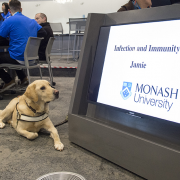Jamie launches Sensory Scientific Exhibition and Discovery Day
ARC Australian Laureate Fellow, Professor Jamie Rossjohn, and colleagues, are helping people with low or no vision to experience the fruits of the latest infection and immunity research through a special Sensory Scientific Exhibition and Discovery Day, held at the Faculty of Medicine, Nursing and Health Sciences, Monash University.
“The Australian Laureate Fellowship really gives you a chance to do something different,” says Professor Rossjohn, who is a Chief Investigator at the ARC Centre of Excellence in Advanced Molecular Imaging, and Infection and Immunity Program leader within the Biomedicine Discovery Institute at Monash University.
“I had been employing people in my research group for sixteen years, but had never employed someone with a disability. Taking proactive measures, one of the first people who I employed was someone with low vision. This experience has really ‘opened my eyes’ to the possibilities for vision impaired people by looking past the disability, to the ability,” says Professor Rossjohn.
Professor Rossjohn says that he realised that this was a community that often didn’t get to hear about science, and that unless scientists made it accessible and employed engaging efforts to explain their research breakthroughs, even revolutionary events like the invention of the microscope could remain intangible to someone who had low or no vision.
Driven by this, Professor Rossjohn’s research team, spearheaded by project leader, Dr Gabby Watson, and other Infection and Immunity laboratories at Monash, organised a half-day scientific exhibition at Monash University, targeted towards a vision impaired community.
The event was held on 31 May 2018 to coincide with Macula Month, and had the full support of Vision Australia and Monash University. Researchers developed an innovative program targeted at those who have low vision or are blind, complete with tactile 3D models, 2D graphic displays, olfactory displays, large print and braille formats,all specifically geared to a low vision/blind audience.
To guide them expertly and creatively in this process, the research team engaged Dr Erica Tandori, who is legally blind, as artist-in-residence for three months to design and develop tactile materials and models that detailed aspects of vaccination, the evolution of flu viruses, and the process of how our bodies recognise pathogens.
Some of the displays included 3D-printed models of immune cells, sounds which were synchronised to live videos of immune cells, and even a section which featured ‘smells from a microbiology lab’. All the models were accompanied by descriptions in both large text and braille. Participants were also able to experience Monash University’s CAVE2 facility which is a 360-degree immersive experience that had immune molecules projected onto enormous surround screens.
Professor Rossjohn says that he considered the event to be a successful showcase of the great science being undertaken at Monash University, which particularly highlighted the latest breakthroughs in infection and immunity research.
Approximately 90 guests attended the exhibition, ranging from primary school students to grandparents. “Most of all, I want people to have a rewarding and educational time,” said Professor Rossjohn.
Professor Rossjohn is using his Australian Laureate Fellowship, ‘A molecular investigation into immune function’, to understand how immune reaction events enable immunity. The project is using multidisciplinary approaches empowered by technological innovations, including the latest advances in atomic and molecular imaging. The research is expected to identify new approaches for the biotechnology industry.
Group Image: Left to Right: Project Leader Dr Gabby Watson, ARC Australian Laureate Fellow Professor Jamie Rossjohn, Ms Liz Visher (ARC), Dr Erica Tandoori, Mr Wayne Seary (ARC). Credit: Hynesite Photography & Monash University.




